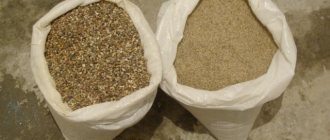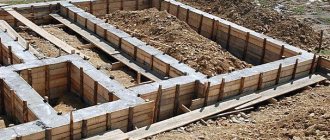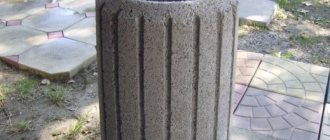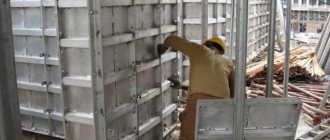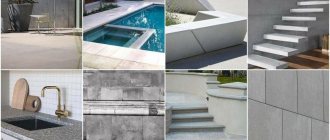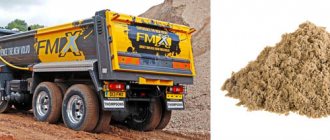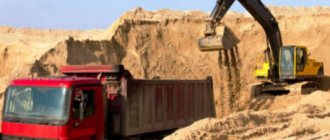Types of quartz sand
Varieties of quartz sand.
Quartz sand can be represented by natural and artificial varieties, which differ in the method of extraction. The first type is ubiquitous in nature; it can be found at the bottom of water basins and in the soil. The fraction of most of its grains can vary within 0.2-1 mm.
There are several ways to extract quartz sand, one of them is quarrying, which acts as the leading method. If mining is carried out above sea level, the material is called mountainous. The type of quarry sand is characterized by pointed shapes and a rough surface, which makes it a valuable building material. After extraction, sand can be further processed, which involves sifting, washing and drying. Another way to extract quartz sand is by developing water basins, in which the particles are washed out and are clean.
Sea sand is not as valuable due to the increased content of mineral impurities. This material has a smooth shape.
Quartz sand has another variety - artificial. But, despite the name, the material has a natural origin, because it is initially found as large crystals. In order for quartz crystals to turn into sand, mechanical action is used, then the fragments are crushed.
Some areas of classification of quartz-based sand can be distinguished, for example, by fractional composition. Thus, quartz can be dusty, the fraction of the material being less than 0.1 mm; fine-grained with a grain size ranging from 0.1 to 0.25 mm; medium – fraction within 0.25-0.5 mm; coarse-grained - 0.5-1 mm, in rare cases the grain size can reach 3 mm.
Sea sand contains a large amount of minerals, so it is rarely used in construction.
Quartz sand can also be classified according to its enrichment. So, it can be unenriched and enriched. The first option is the mineral in its original form, not subject to processing to increase the amount of silicon dioxide in the composition. The second option is represented by sand, which contains a quartz content increased by a certain percentage, which can be achieved by eliminating a number of impurities. Thus, the white material does not contain organic compounds, clay impurities, or iron oxides, which can be achieved after sifting, washing and drying.
Quartz sand can also be classified according to enrichment technology.
The initial enrichment step involves fractionation and washing. The next step could be gravitational enrichment, which aims to separate the components of the composition by density.
The particles may have different colors. There is natural and dyed material. Natural is characterized by shades from pale yellow to brownish yellow. And with artificial coloring, stable paints based on synthetic binders are used.
Sands classified according to the degree of preparation have different technical characteristics. Thus, production may require fractionated material, dry or calcined, the latter of which is characterized by the absence of moisture in the composition, which is achieved by calcination.
PHYSICAL PROPERTIES
| Mineral color | itself colorless or white due to fracturing, with impurities it can be colored in any color (purple, pink, black, yellow, brown, green, orange, etc.) |
| Stroke color | white |
| Transparency | translucent, transparent |
| Shine | glass |
| Cleavage | the very imperfect rhombohedral cleavage along {1011} is the most common, and there are at least six other directions |
| Hardness (Mohs scale) | 7 |
| Kink | uneven, conchoidal |
| Strength | fragile |
| Density (measured) | 2.65 g/cm 3 |
| Radioactivity (GRapi) | 0 |
Once a rare and valuable work of art, glass is now a common manufacturing process. Glass products are used as industrial and household containers, insulators, reinforcing fibers, lenses and decorative arts. The materials used to make different types of glass may vary, but the general process for making it is described below.
Normalization of characteristics
Sand characteristics table.
The main regulatory document is GOST 2138-91. The document reflects the requirements for leading characteristics and quality parameters. Thus, 5 groups of material can be distinguished, each of which must contain a specified amount of clay in the range of 0.2-2.0%. The silicon dioxide content in sand should vary from 93 to 99%; material with a certain content of this component will correspond to group K1-K5.
The material may also have its own uniformity coefficient; with increasing value, the sand mixture is characterized by greater homogeneity. Sand also has a certain fractional composition, which reflects the size of the particles. GOST and humidity indicators are taken into account. Dry formulations contain a maximum of 0.5% moisture, while wet formulations should not contain more than 4.0%. As for raw materials, this figure does not exceed 6.0%.
Performance characteristics of quartz sand
Sand parameters that affect the quality of work and determine the scope of application include:
Table of use of quartz sand depending on the fraction.
- bulk density, which is limited to 1300-1500 kg/m3;
- true density – 2600-2700 kg/m3;
- thermal conductivity, which varies within 0.30 W/(m∙°C);
- the maximum melting temperature of quartz sand is 1050°C, which is sufficient for carrying out any construction work;
- ordinary quartz material, being in a loose state, has a volumetric weight of 1500 kg/m3, while the volumetric weight is 1600 kg/m3.
As for the maximum melting temperature, in the process of casting quartz-based products, a temperature range of 1700°C or more is used. The shape and fractionation of the composition has a significant impact on the heat-insulating characteristics. Thus, with an increase in the density of grains and smaller gaps, the thermal conductivity coefficient turns out to be greater.
Steps
Using the oven
- Buy quartz sand.
Quartz sand is the main ingredient for glass production. Iron-free glass is prized for its clarity because if the glass contains iron, the glass will appear greenish.
- Wear a mask if you are working with very fine quartz sand. If inhaled, it may irritate the throat and lungs.
- Quartz sand can be purchased in online stores. It is quite cheap, a bag weighing 25 kg costs around 200 rubles. If you want to work on an industrial scale, then for large quantities specialized sellers can offer good prices - sometimes less than 2,000 rubles per ton.
- If you cannot find sand that contains few impurities, the greenish tint effect can be compensated for by adding small amounts of manganese dioxide. And if you want greenish glass, leave the iron as is!
- Add sodium carbonate and calcium oxide to the sand.
Sodium carbonate (called soda ash) reduces the temperature at which industrial glass is produced. However, it causes water to corrode the glass. Therefore, in order to neutralize this phenomenon, calcium oxide, or lime, is additionally introduced into the glass. In order to make glass more resistant, magnesium and/or aluminum oxides are introduced into it. Typically, these additives occupy no more than 26–30 percent of the glass composition.
Depending on the purpose of the glass, add other chemicals.
The most common additive for decorative glass is lead oxide, which provides the shine of crystal, as well as its low hardness, making it easier to cut, and its low melting temperature. Eyeglass lenses may contain lanthanum oxide, which is used for its refractive power, while iron promotes the absorption of iron by the glass.
- Lead crystal can contain up to 33 percent lead oxide, but the more lead, the more experience it takes to shape the molten glass, so many glassmakers choose low lead content.
As noted above, iron impurities in quartz glass give it a greenish appearance, so iron oxide is added to enhance the greenish tint, just like copper oxide. Sulfur compounds give yellowish, amber, brownish and even black tints, depending on how much additional carbon or iron is added to the glass charge.
Place the mixture in a good temperature-resistant crucible.
The crucible must withstand the exceptionally high temperature that is reached in the furnace. Depending on the additives, it can range from 1500 to 2500 degrees. The crucible should be such that it is not difficult to grasp it with metal tongs and rods.
Melt the mixture until liquid.
For industrial silicate glass this is done in a gas-heated furnace; special glasses can be melted in an electric, pot or muffle furnace.
- Quartz and sand without impurities transform into a glassy state at a temperature of 2300 degrees Celsius. The addition of sodium carbonate (soda) reduces the temperature required for glass formation to 1500 degrees Celsius.
This involves stirring the glass until it is evenly thick and adding substances such as sodium sulfate, sodium chloride or antimony oxide.
Mold the molten glass.
Glass can be formed using one of the following methods:
- The glass melt can be poured into a mold and allowed to cool. This method was used by the Egyptians and is how most optical lenses are created.
A large amount of molten glass can be collected at the end of a hollow pipe and then blown out by turning the pipe. Glass is formed by the air blown into the pipe, the force of gravity acting on the molten glass, and any tools the glassblower uses to work the molten glass.
This process is called annealing, and it removes any point sources of stress that may form as the glass cools. Unannealed glass is much less durable. Once the process is complete, the glass can be coated, laminated, or otherwise treated to increase strength and durability.
Using a Charcoal Fryer
- Make a makeshift oven out of a charcoal-fired barbecue grill.
This method uses the heat generated by flames from burning charcoal to melt quartz sand into glass. The materials used are relatively cheap and available - theoretically, to prepare everything you need to make glass, you only need to run to a hardware store. Use a large barbecue grill - a standard size dome grill will do. It should be as thick-walled and durable as possible. Most BBQ grills have a vent on the bottom - open it.
- Even at the extremely high temperatures achieved with this method, it can be very difficult to melt sand on a grill. Before you begin, add a small amount (about 1/3-1/4 of the sand's volume) of washing soda, lime and/or borax to the sand. These additives reduce the melting point of sand.
If you're going to blow glass, have a long, hollow metal tube handy. If you are going to pour glass into a mold, prepare it in advance. You need a shape that won't burn or melt from the heat of the molten glass, graphite works great for this purpose.
This method involves heating the barbecue grill beyond its normal temperature limits - so much so that it may even melt the grill itself.
Careless operation using this method poses the risk of serious injury or even death
. Work with caution. Keep a large amount of soil, sand, or a fire extinguisher designed for high temperatures on hand in case you need to reduce the intensity of the fire.
Take all possible precautions to protect yourself and your belongings from high temperatures.
Work using this method on a concrete surface outdoors, with sufficient space around.
Do not use irreplaceable equipment. Stay away
from the grill when you are boiling glass. You will also need to wear as much protective clothing as possible, including:
- high-strength gloves or oven mittens;
welding mask;
Using duct tape or some other means, bend the hose so that it blows directly into the vent hole on the bottom without touching the body of the grill. You'll probably need to attach a hose to one of the grill's legs or wheels. Place the vacuum cleaner itself as far away from the grill as possible.
- Make sure that the hose is secure and does not move: if it comes loose while glass is brewing, do not
approach the grill if it is very hot.
Turn on the vacuum cleaner to check the position of the hose. A precisely placed hose will blow directly into the vent.
Use more charcoal than you would for roasting meat. Successful results are observed when the grill is filled almost to the brim. Place a cast iron pan or crucible filled with sand in the middle of the grill, sprinkled with charcoal.

